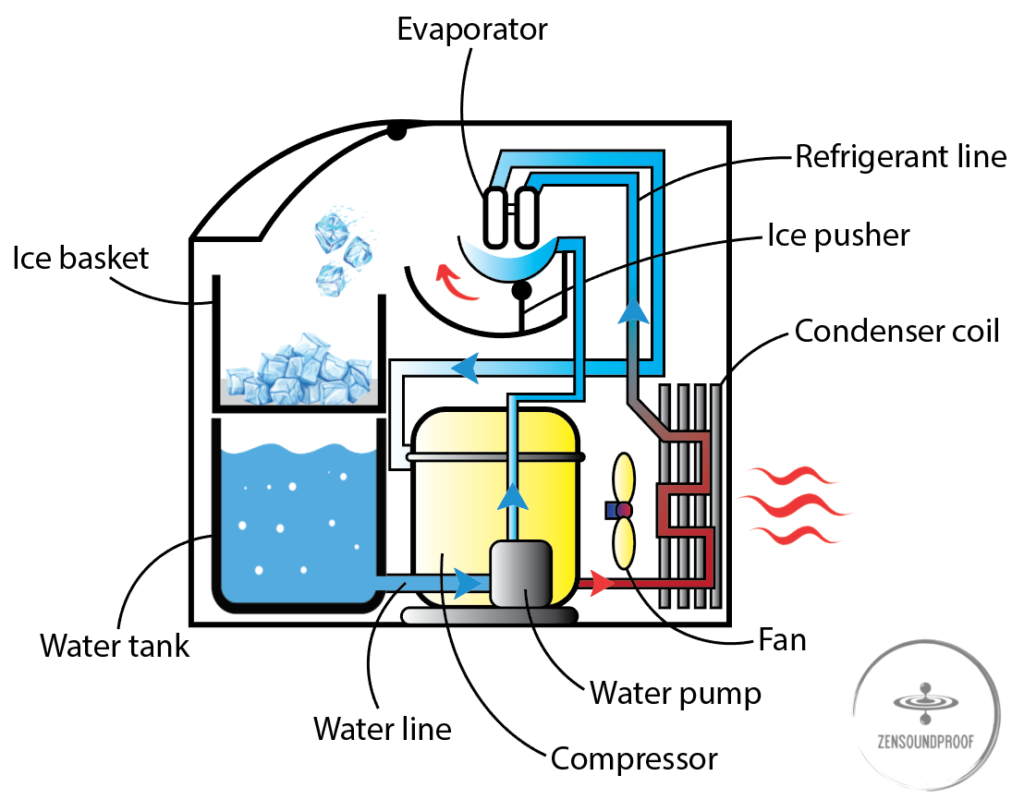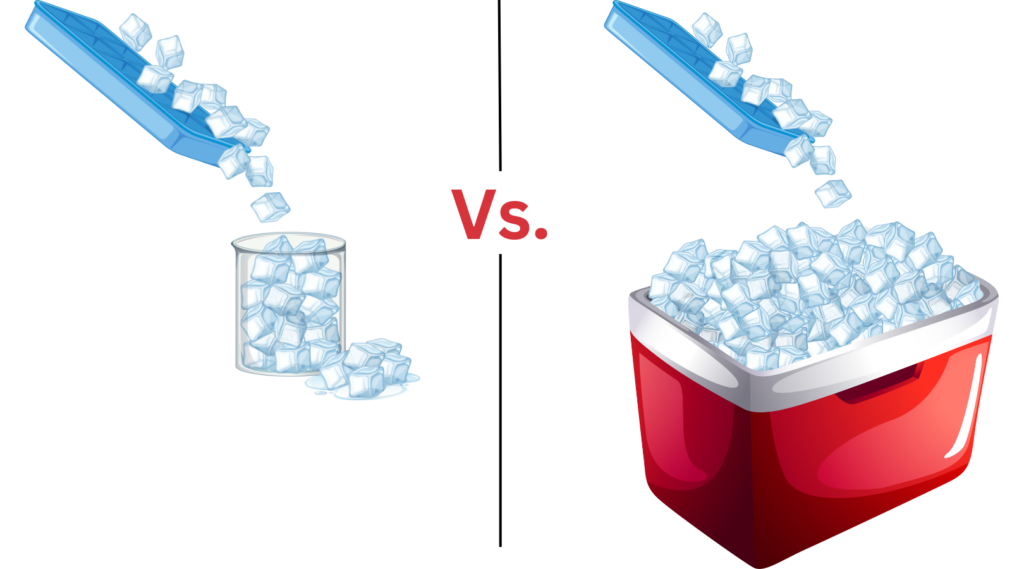Choosing the quietest ice maker on the market is a faster and more convenient option than the traditional ice tray method. Of course, we’re focusing on quiet models here because you don’t want an ice maker that’s unbearably loud.
So, what makes a countertop ice maker quiet, and why is it more useful than ice cube trays or buying bags of ice?
That’s exactly what I look at in this article. Below, I review my top picks for quiet countertop ice makers and how to choose the right model. Before we jump into the reviews, let’s look at what factors affect ice maker noise levels.
Factors that Affect Noise
An ice maker essentially works in the same way as a freezer. The important components are:
- A refrigeration system that features a compressor, condenser, and evaporator. It works the same as an AC unit or refrigerator’s cooling system.
- A motor that drives the refrigeration unit and water pump.
- A water pump to move water from the reservoir to the ice tray.
- A system for removing the ice, which might include a piston or pump.

An ice maker works as follows:
- Water is pumped from the reservoir into the chilled ice tray.
- The refrigeration system keeps it cool by removing heat within the ice-making box using a refrigerant fluid. This method of refrigeration is the same in freezers and is called a vapor compression cycle.
- As the refrigerant warms by taking in the heat, it turns into a gas. This is then forced through the condenser and releases the heat out of the ice maker. This causes the refrigerant to become a liquid again. It repeats this cycle until the ice is frozen.
- Once the ice is frozen, a solenoid valve triggers a bypass in the refrigerant system. This sends a small amount of warm gas past the ice tray, slightly melting the ice. Check out the video below for an overview.
- After loosening the ice, it’ll drop into the collection tray. Some models might feature a piston to give it an extra push.
- The ice maker then repeats the cycle to produce more ice.
If you know anything about electronic mechanisms, you can probably see where the noise comes from in an ice maker. There are 3 main sources:
- The water pump and motor (airborne and impact noise)
- The refrigeration lines (airborne noise)
- Falling ice (impact noise)
Quiet ice makers will generally have systems that counteract these noise sources using insulation or quiet mechanisms. While we can do a lot to reduce the noise an ice maker produces, we can never remove it completely.
How Many dB?
An ice maker can emit between 30dB and 50dB depending on the model and its design. Of course, this is quite a range, but it’s dependent on the size, amount of ice produced, and quality of construction.
For a comparison to real-world noises, 30dB is about the same as a whisper, and 50dB is roughly the same as a normal refrigerator. While an industrial ice machine could certainly get louder, we’ll only focus on quiet, household models. As such, 50dB is about the upper limit we’ll want to consider.
Unfortunately, it’s not all that common for manufacturers to include a decibel rating for their ice makers. I’ll add them where possible. But if they’re missing, we’ll instead have to rely on user reviews that discuss noise levels.
Our Top 5
Along with noise levels, I’ll also consider important factors such as size, amount of ice produced, and energy efficiency. Hopefully, this’ll allow you to pick the best model, whether you’re catering a party or you simply use a lot of ice!
1. Top Pick: Silonn Countertop Ice Maker
- Noise level: 35dB
- Ice cap.: 26lbs/24hr.
- Ice basket: 1.3lbs.
- Ice type: Bullet ice
- Energy efficiency: 14.8kWh/100lbs.
- Size:
12.3″ Depth
8.7″ Width
12.5″ Height
The Silonn Countertop Ice Maker is my top pick because it’s quiet and works quickly. At only 35dB, it’s on the lower end of the ice maker noise scale, and you’ll have a job finding a quieter model. While they certainly exist, the Silonn is a great balance of price and noise.
It makes bullet ice cubes, which melt slower than normal ones and are also easier to fit in water bottles. It can produce 9 cubes in 6 minutes, and can make a total of 26lbs. of ice in 24 hours. However, its ice basket is only 1.3lbs., so you’ll have to empty it regularly!
The water reservoir is around 4 pints, and it’s best to use bottled water. Some users claim their ice machine has broken down from using tap water, as it can clog the filters with scale.
While the manufacturer doesn’t list an energy efficiency rating, we can calculate it using the Code of Federal Regulations (explained more below). Silonn’s energy efficiency is 14.8kWh/100lbs. of ice, which is pretty standard for a countertop ice maker.
In terms of downsides, it’s not a major one, nor is it specific to this model. It’s not designed for storing ice – there’s no refrigeration in the ice basket. As such, you’ll need somewhere to put the ice once it’s made otherwise it’ll melt. The water does then return to the reservoir for more ice, but this is a bit of a waste of energy.
- Quiet – only 35dB of noise.
- Can make ice quickly.
- Doesn’t use a lot of energy.
- Isn’t designed to store ice after it’s made.
2. Top Budget Pick: Homelabs Portable Ice Maker
Although the Homelabs Portable Ice Maker isn’t drastically cheaper than the Silonn, it’s worth including as a budget pick. It has the same 24-hour production capacity, but its basket is bigger. While it’s still only 1.5lbs., the extra space is useful.
Another advantage it has over the Silonn is that it can make ice in 2 sizes. They’re still bullet-shaped ice cubes, but you can have small or medium cubes. This makes it a good pick if you’re making different iced drinks (such as cocktails), as the cubes can cool drinks at different speeds.
At 18.7lbs., it’s a pretty heavy ice maker. However, if you plan to use it as a countertop model, this isn’t a massive issue. Unfortunately, we don’t have a noise level, but users’ reviews are positive regarding its quietness.
It has a 4.6-pint water reservoir and can produce a batch of ice in 8 minutes. Homelabs claims its cylindrical cubes are made faster, but they’re hollow, so also melt faster. It’s not a massive issue, but just make sure you transfer it to the freezer quickly.
Its energy efficiency based on its daily output is 11.1kWh/100lbs. However, one reviewer measured the machine’s ice output to be around 20lbs./day. Based on this, this ice maker machine has an efficiency of 14.4kWh/100lbs., putting it on par with the Silonn.
One user mentions that you must use cold water to make ice, whereas other models allow you to use room temperature water. This is because tepid water can take longer to freeze, or not freeze fully. If you’ve got space in your refrigerator for a jug of water, it’s not a massive issue. It shouldn’t come as much of a surprise considering it’s about as cheap as you’ll want to go with an ice maker.
- Makes ice in 2 sizes.
- Has a decent-sized reservoir.
- Budget-friendly ice maker.
- Requires cold water to make ice.
- Not as efficient as more expensive models.
3. Top Premium Pick: Gevi Household Countertop Ice Maker
The Gevi Household produces nugget ice, which is for a different purpose to bullet-shaped ice cubes. Rather than cooling down drinks, nugget ice is easier to blend. The air pockets mean it breaks up more easily, causing less wear to your blender.
Of course, you can use it for cooling drinks, but it’ll melt faster than bullet ice.
The Gevi is essentially a blend between domestic and industrial ice makers. It has a larger capacity (30lbs. of ice in 24 hours) and a larger basket – 4.8lbs. Based on these figures, we can calculate its energy efficiency to be 13.6kWh/100lbs. of ice, making it the most efficient model so far. Read on to find even more efficient models.
It features a touch panel that’s easy to use and has indicators telling you when you need to clean or add more water. The ice tray has a window, so you can see how much ice is actually in there. The water reservoir is 3 quarts, too. Although the basket isn’t refrigerated, it’s insulated. This ultimately doesn’t stop the ice from melting, but it certainly slows down the process.
Unfortunately, there’s no specific decibel rating given for this product. However, users state that it’s quieter than their refrigerator, so it’s fair to assume it fits into our bracket of quiet ice maker. Importantly, it has the 2nd highest star rating for noise level of our list of ice makers.
One big downside mentioned by users is the lack of water supply connection. While this isn’t necessarily an issue, it’s certainly a feature you’d expect on a model at this price point. You can still manually fill it, but you must do so quite often because of its higher output.
- Large basket capacity.
- Fairly easy to use.
- Insulated ice basket.
- Makes ice slowly.
- Lacks a water supply connection.
4. Top Portable Pick: ecozy Portable Ice Maker
- Noise level: 35dB
- Ice cap.: 26lbs/24hr.
- Ice basket: 1.3lbs.
- Ice type: Bullet ice
- Energy efficiency: 11.1kWh/100lbs.
- Size:
8.74″ Depth
11.57″ Width
11.42″ Height
The ecozy Portable Ice Maker is a good compromise between weight and noise level. At 14.7lbs., it’s fairly easy to carry and includes a handle to make this easier. While it’s certainly not the lightest countertop ice maker, it’s pretty quiet.
Its operating noise level is only 35dB, which is the same as the Silonn model above. The ecozy was nearly my top pick, but the Silonn is better value for money from a performance perspective. Also, the Silonn doesn’t include a handle, so the ecozy is the better portable model.
The ecozy has the same capacity (26lbs. in 24 hours) and can make 9 bullet ice cubes in only 6 minutes. While the product doesn’t list a water tank or ice basket size, it’s fair to assume they’re both the same as the Silonn because they’re the same capacity.
One standout feature of the ecozy is its energy efficiency. It uses a maximum of 120W of power (in comparison, the Silonn above has a power rating of 160W), meaning its efficiency rating is 11.1kWh/100lbs., making it the most efficient on this list.
Some users state its volume of ice produced isn’t massive, stating it makes ice quickly, just not very much. This is arguably a downside of all portable or countertop ice machines, so it’s really not a big deal. If you need more ice constantly, consider the model below.
- Low operating noise.
- Carrying handle makes it convenient to take to parties, camping, etc.
- Very energy efficient.
- Doesn’t produce a great enough volume of ice – requires you to produce a backlog.
5. Best for High Volume: Humhold Countertop Ice Maker
- Noise level: 45dB
- Ice cap.: 44lbs/24hr.
- Ice basket: 2.4lbs.
- Ice type: Rock ice
- Energy efficiency: 12kWh/100lbs.
- Size:
13.8″ Depth
9.6″ Weight
14.5″ Height
While the ice makers on this list so far have all had similar capacities, the Humhold Countertop Ice Maker is much larger. Its capacity is 44lbs. per day, which is pretty impressive. Its operating noise level is 45dB, making it the loudest on this list with an explicit rating. However, for the volume of ice and size of the machine, this isn’t too bad.
It makes rock ice, whereas the others on this list make bullet or nugget ice. Rock is essentially traditional ice cubes, and this machine can make 24 in as little as 12 minutes. Better yet, there are 12 sizes available, which you can change using the plus and minus buttons.
The Humhold is 20.9lbs., making it the heaviest on this list. However, this still isn’t an unreasonable weight, it just means it’s less portable than, say, the ecozy. When you balance this against its ice capacity, it’s arguably worth the extra weight.
Its LCD control panel is easy to use and features a 24-hour preset, so you can start making ice at a specific time. There are also 2 ways to add water to the 3.3-quart reservoir: from a jug or directly from a bottle with the bottle base. It’s not the most amazing feature, but it makes filling from a bottle easier.
Its energy efficiency rating is 12kWh/100lbs. of ice, which is absolutely fine. However, a potentially large downside is that the ice comes out in a solid waffle-shaped block rather than as individual cubes. If you catch it straight away, you can break it up. If not, it begins to melt and will then freeze together as a block. Sure, it’s not the biggest deal, but there’s not much you can do with a massive block of ice!
- High capacity is ideal for parties.
- Not too loud considering the size.
- It’s still fairly easy to store.
- Ice doesn’t come out as separate cubes.
Buying Guide
Choosing the right ice maker for your needs depends on more than just the noise level. After all, there’s little point in choosing a machine that’s quiet but doesn’t make enough ice. So, here are what I consider to be the most important factors when choosing a suitable ice maker.
Capacity

An ice maker’s capacity refers to how much ice it can produce in 24 hours. Although not directly related to its speed, an ice maker with a larger capacity will generally make ice quicker, or at least make more of it.
For home use, the standard is around 26lbs. of ice per day. This equates to just over 1lb. of ice per hour, which should be enough for normal daily use. Of course, if you get through a lot of ice, opt for a bigger capacity. For example, the Humhold produces more, or you could opt for an under-counter model, such as this Euhomy, which produces 80lbs. per day.
Alternatively, ensure you build up a backlog of ice in your freezer.
Size and Portability

Countertop ice makers don’t need to be super portable, but it helps. After all, you might not want it living on your countertop all the time, so being able to pick it up is useful. The definition of portable ice makers will depend on what you’re happy to lift, but aim for one that’s under 20lbs.
If you plan to take the ice maker in your RV, a lighter model is better. Also, look for one with a handle so it’s easier to pick up.
Similarly, size is relative to the amount of storage space you have. Countertop and portable models are usually fairly compact. However, choosing an ultra-compact model will mean sacrificing some ice basket space.
Ice Basket

The ice basket is where ice is stored once it’s been made. It’s rare for countertop ice makers to have refrigerated baskets, although this is more common on commercial models. As such, you’ll need to move ice to the freezer to stop it from melting.
An ice maker with a 26lbs. capacity will typically have a removable ice basket of up to 1.5lbs. However, because they’re not refrigerated, it’s best to move ice before the basket is full. Waiting for it to fill will usually mean some ice melts, meaning the remaining ice will stick together when it refreezes.
It’s common for countertop models to have a water return tray under the basket. This catches melted ice, which is then returned to the water reservoir for recycling. While this is better than the water simply going to waste, it’s not a super efficient use of energy. Again, you can solve this by removing ice once it drops into the basket.
A larger ice basket isn’t always useful for the same reason. Unless you have a very quick ice maker with a large capacity, a larger ice basket will just mean there’s more melted ice.
Ice Type
Typically, ice makers don’t produce traditional cubes because they take the longest to freeze. Instead, you’ll have 2 kinds: bullet and nugget.
- Bullet ice is, unsurprisingly, shaped like a bullet and is usually hollow. It means it freezes quicker, but melts slower than nugget ice. It’s best for cooling drinks and making cocktails.
- Nugget ice is made from layers of crushed ice frozen into solid shapes. It’s less dense than bullet ice, meaning it melts quicker. However, ice nuggets are better for making smoothies and blended drinks, as it causes less damage to your blender. A nugget ice maker is also better for eating because it breaks more easily.
The ice type you choose will depend on your main use. It shouldn’t be too difficult to determine which is the most suitable option from the information above.
Some ice makers will also make different sized ice. This is helpful if, for example, you need to fit ice in a bottle, as smaller cubes will be better than larger cubes. However, ice size isn’t a common deciding factor when picking an ice maker.
Speed
Speed refers to how quickly an ice maker can produce its first batch after you turn it on. There’s a rough correlation between speed and capacity, as high-capacity machines often make larger batches. In turn, this can take longer than a machine that makes smaller batches.
Take the Silonn for example. It can make 9 cubes in 6 minutes, which is pretty quick. But you must also consider the time between batches, which can be up to 20 minutes. In turn, it can then take a few hours to fill the ice basket. You can often speed this up by using ice cold water when filling.
For the clearest information, look at how quickly the machine can produce its first batch of ice. From there, check user reviews to see if there are comments about its speed. It’s an important factor for most users, so you should find some relevant information.
Water Tank & Water Supply
Most countertop ice makers have a built-in water reservoir from which it draws water to be frozen. As you can imagine, a larger reservoir means you don’t need to fill it as often, although this also depends on the machine’s capacity.
However, some models can be connected directly to a water supply. This is arguably a more convenient option, as it means you don’t have to worry about refilling it. If you have a suitable water connection, it’s a bit of a no-brainer.
Noise Level
There’s not much more to say about noise levels that I haven’t mentioned above. Ice makers with better build quality will generally be quieter than budget models due to superior design and parts.
When picking an ice maker based on noise level, think about where it’s going to be and what potential ambient noise might be in the area. For example, an ice maker in a kitchen won’t need to be much below 50dB, as this is roughly the noise produced by a refrigerator.
On the other hand, an ice maker for an RV might need to be much quieter, as there could be less ambient noise in the area.
Either way, the models on this list aren’t considered loud, so you should be fine to have them in any space.
Energy Efficiency
Domestic ice makers aren’t too energy intensive, although few models list an energy efficiency rating. Although there is an Energy Star category for ice makers, it only refers to commercial models. These include ice cooling mechanisms that keep the ice below 0 degrees, which means they use more power.
The energy efficiency of ice makers is expressed in kWh/100 lbs of ice produced. We can use the ice maker capacity (in lbs of ice per day) to estimate the hours needed to produce 100 pounds of ice. We then multiply this duration by the rated power.
Of course, the above calculation is an average. There’s a significant difference in power draw during the various operations of the ice maker. One user measured the power drawn by the Ecozy. It consumed 100W when making ice cubes and spiked at 120W when harvesting.
A domestic model will generally have a rating of 120-170W. This means an hour of use would consume 0.12-0.17kWh of energy. At a standard electricity rate of $0.06 per kWh, it’ll cost you up to $0.011 to run for an hour. As you can see, this isn’t too bad.
How to Make an Ice Maker Less Noisy?
Based on the noise sources given at the beginning of the article, here are some suggestions for reducing the noise emissions of your ice maker.
Clean It
A good starting point is to clean the machine. While countertop ice makers don’t really need defrosting, it’s worth checking water pipes for scale buildup and dirt. This can cause noise due to inefficient pumping.
Consider running a descaling fluid through the machine, but obviously give it a good clean after. Then, only use bottled water to avoid the issue in the future.
Refrigeration Circuit Problems
Condenser fans and compressors can be some of the loudest components in an ice maker. Unfortunately, there’s not loads you can do about these, short of replacing them. At that point, it might just be worth buying a new ice maker.
Resonance Problems
If your ice maker machine is making a rattling noise, it could be an issue with resonance. Specifically, the housing could be flimsy or it could be in contact with another object that it’s making vibrate.
To sort this, place the ice maker against something heavy with a layer of rubber in between for damping. A wall could be suitable provided the vibrations are dampened enough. However, be sure you don’t obstruct the ventilation holes, as this could cause the ice maker to overheat.
Water Supply Issues
Finally, there could be water supply issues. Ideally, your countertop ice maker will have a low water indicator to avoid any problems or noises arising from the water supply.
If it’s low on water, an ice maker can hum or click as it tries to suck up water that isn’t there. It’s an easy one to fix: just make sure it doesn’t run out of ice. Ideally, connect it directly to a mains water supply to avoid this.
Final Thoughts
I hope this article has helped you to narrow down your options for a quiet countertop ice maker.
My top pick is the Silonn Countertop Ice Maker. It’s by far the quietest on this list and has decent capacity and ice-making speed. Of course, if it doesn’t meet your needs, any of the other models should be a good alternative.
Do you have any suggestions for a quiet ice maker, or any tips for making an existing model quieter? Drop your comments below!





